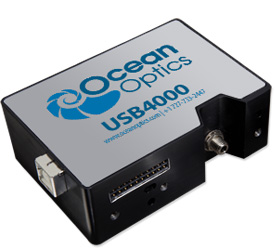| USB4000-FL Fluorescence Spectrometer
 Our next-generation miniature spectrometer platform for fluorescence spectroscopy is the USB4000-FL. Preconfigured with an L4 Detector Collection Lens to increase light-collection efficiency and reduce stray light, the high-sensitivity USB4000-FL covers the 360-1000 nm wavelength range. It also features a programmable microcontroller that lets you implement operating parameters in the software -- control the spectrometer and external excitation sources, and even retrieve data on external objects! Our next-generation miniature spectrometer platform for fluorescence spectroscopy is the USB4000-FL. Preconfigured with an L4 Detector Collection Lens to increase light-collection efficiency and reduce stray light, the high-sensitivity USB4000-FL covers the 360-1000 nm wavelength range. It also features a programmable microcontroller that lets you implement operating parameters in the software -- control the spectrometer and external excitation sources, and even retrieve data on external objects!
Programmable Microcontroller
The USB4000-FL's onboard programmable microcontroller provides you with considerable flexibility in controlling the spectrometer and accessories. Through a 22-pin connector, you can implement all operating parameters in the software: control light sources, create processes, and retrieve information on external objects. You have access to 8 user-programmable digital Inputs/Outputs for interfacing to other equipment. (Contact an Applications Scientist regarding what you'll need to program the GPIOs.)
Optimal Performance
The USB4000-FL provides you with an affordable, high-performance 3648-element linear CCD-array detector with an optical bench that's small enough to fit into the palm of your hand. The USB4000-FL works the same way as other Ocean Optics spectrometers; it accepts light energy transmitted through single-strand optical fiber and disperses it via a fixed grating across the linear CCD array detector, which is responsive from 200-1100 nm.
Plug and Play Operation
The USB4000-FL interfaces to a PC, PLC or other embedded controllers via USB 2.0 or RS-232 serial port. Data unique to each spectrometer is programmed into a memory chip on the USB4000-FL; our spectrometer operating software reads these values for easy setup and hot swapping among PCs.
Accessory Filters
The USB4000-FL can be used with our LVF-series Linear Variable Filters to construct systems with excellent separation of excitation and fluorescence energy. Use our LVF-L Linear Variable Low-pass Filter to fine tune your excitation source for maximum signal with minimum overlap; and/or use our LVF-H Linear Variable High-pass Filter on the detection side. Inline holders and cuvette fixtures make deployment of these filters easy.
Specifications
|
Physical |
| Spectrometer Dimensions: |
89.1 mm x 63.3 mm x 34.4 mm |
| Weight: |
190 grams |
| Detector Specifications |
|
Detector: |
Toshiba TCD1304AP Linear CCD array |
| Detector range: |
200-1100 nm |
|
Pixels: |
3648 pixels |
|
Pixel size: |
8 μm x 200 μm |
|
Pixel well depth: |
100,000 electrons |
| Signal-to-noise ratio: |
300:1 (at full signal) |
| A/D resolution: |
16 bit |
| Dark noise: |
50 RMS counts |
| Corrected linearity: |
< 0.2% |
| Sensitivity: |
130 photons/count at 400 nm; 60 photons/count at 600 nm |
| Optical Bench |
| Design: |
f/4, Asymmetrical crossed Czerny-Turner |
| Focal length: |
42 mm input; 68 mm output |
| Entrance aperture: |
200 µm wide slit |
| Grating: |
Grating #3 -- groove density 600 lines per millimeter, 360-1000 nm, 500 nm blaze |
| Detector collection lens: |
Yes, L4 |
| Fiber optic connector: |
SMA 905 to 0.22 numerical aperture single-strand optical fiber |
| Spectroscopic |
| Wavelength range: |
360-1000 nm |
| Optical resolution: |
~10.0 nm FWHM |
| Signal-to-noise ratio: |
300:1 (at full signal) |
| A/D resolution: |
16 bit |
| Dark noise: |
50 RMS counts |
| Integration time: |
3.8 ms - 10 seconds |
| Dynamic range: |
2 x 108 (system), 1300:1 for a single acquisition |
| Stray light: |
<0.05% at 600 nm; 0.10% at 435 nm |
| Electronics |
| Power consumption: |
250 mA @ 5 VDC |
| Data transfer speed: |
Full scans to memory every 5 ms with USB 2.0 port |
| Inputs/Outputs: |
Yes, 8 onboard digital user-programmable GPIOs |
| Analog channels: |
No |
| Auto nulling: |
Yes |
| Trigger modes: |
4 modes |
| Strobe functions: |
Yes |
| Connector: |
22-pin connector |
| Computer |
| Operating systems: |
Windows 98/Me/2000/XP, Mac OS X and Linux with USB port; Any 32-bit Windows OS with serial port |
| Computer interfaces: |
USB 2.0 @ 480 Mbps (USB1.1 compatible); RS-232 (2-wire) @ 115.2 K baud |
| Peripheral interfaces: |
SPI (3-wire); I2C inter-integrated circuit | |

